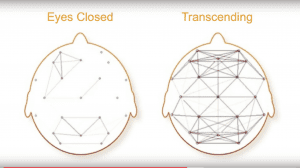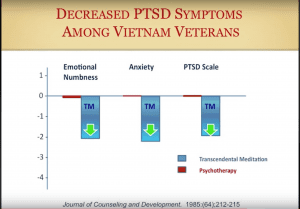This blog post is part two of ‘A Scientific Perspective by Quantum Physicist John Hagelin, PhD”
Different Styles of Meditation and the Brain
Dr Hagelin talks about how transcending regularly helps our brain development. He starts by describing the different states the mind moves through when meditating. “There are different levels of mind, from the surface, active mind, to the quietly settled states of mind, to absolute silence within the mind.”
This next chart shows that those three levels of the mind through different meditations have completely different styles of functioning in the brain.

Dr Hagelin explains three alternate states of the mind when doing different meditations. These are shown in the chart and are the most talked about in scientific circles: “These three levels of mind correspond to the three major categories of meditation discussed in the scientific literature.”
The outward, active thinking, concentration and focus category is at the top. The brain looks completely different in the next category, showing a quieter mind. This is often called mindfulness in the literature and uses various techniques of quiet self-reflection. Dr Hagelin explains the last category as being “the meditating state, and through Transcendental Meditation, it uses a completely unique style of functioning. It is the entire brain performing in a totally integrated way, a really coherent way.”
And how is this more beneficial?
“That orderly, coherent, and integrated function of the brain translates to coherent thinking. Coherent, clear, orderly speech, and purposeful, effective action. And that means successful and fulfilling action.”
Here is another chart looking at the electrical activity of the brain. “When you see a bar connecting between the dots, it means those two parts are talking to each other, functioning in an intelligent, coherent way.”

On the left, a subject sitting with eyes closed at rest. On the right, this is the same subject after having learnt to meditate, and they monitored this during a TM session. “As you can see, the entire brain is functioning in this very coherent way. You don’t see that in waking, dreaming, sleeping, hypnosis, in any other state but in this meditative state.”
Dr Hagelin explains why an orderly brain functioning is something we should work towards. “Orderly brain function correlates with IQ, learning ability, academic performance, creativity, alertness, reaction time, moral reasoning, phycological stability, and emotional security. Everything good about the brain depends on its orderly functioning.”
To make it even more appealing, Dr Hagelin mentions anyone can do TM – from 10 years old to the elderly.
Children and Stress
“We are in living in an epidemic of stress”, mentions Dr Hagelin. “Millions of children diagnosed with stress and ADHD are medicated for it, but with very little to do about it.” ADHD is a symptom of today’s modern stress.
According to the latest study among junior high school students, 12 weeks of meditation twice a day, lasting 12 minutes, caused a normalisation of the brain function and a marked drop in the symptoms of ADHD.
In over four hundred schools, teachers are incorporating TM into the school curriculum.

“TM in general causes holistic development of the brain, the total development of the personality, and is named in the literature as “self-actualisation”.”

As you can see, other meditations don’t have so much effect because they don’t go deep enough.
PTSD
Because of the highlighted amount of benefits to the brain, Transcendental Meditation is also great for helping with Post Traumatic Stress Disorder. The deeper rest of TM can deactivate the fear centre even in the very first meditation. Sometimes for people, it can take maybe a couple of months of twice-a-day meditation for us to see clearly these remarkable reductions in PTSD.

“PTSD is the worst, most terrible thing that can destroy a life, as it’s the most acute type of stress. But through TM, in a relatively short period, it seems to dissolve effortlessly. And that is why we are seeing the modern militaries of the world, the department of defence, the veterans administration, and the academies and universities in America, incorporating TM into the curriculum. As an antidote to stress, and as a vaccine inoculating the troops against the ravages of war stress.”
Dr Hagelin ends by mapping out the next stages if you were to decide to learn TM, “The next step would involve a second talk for free with one of your local teachers, where they will talk about the mechanics of it, about how it’s different from other types of meditation, and why it’s so easy, so effortless and universally effective.”
Then he explains how the course is 4 days of instruction, and after this, you are a master meditator. Once you meditate, you can call on any TM teacher, or any TM centre across the world, whenever you need a top-up or some advice.
















